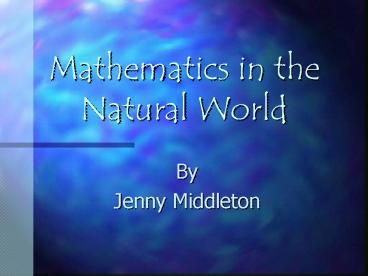Mathematics in the Natural World - PowerPoint PPT Presentation
1 / 50
Title: Mathematics in the Natural World
1
Mathematics in the Natural World
- By
- Jenny Middleton
2
OUTLINE
- I. Mathematics and the Beginnings of
Civilizations - II. Ongoing Question of Abstraction
- III. Finality of Abstraction
- IV. NATURE A Continual Portrait of
Mathematics
3
Mathematics and the Beginnings of Civilization
- I.
4
Babylonians Egyptians
- Concept of angle
- Crude calculations areas of fields
- Division of fields
- Herodotus, Egyptian geometry, and flooding of Nile
5
II.
- Ongoing Question of Abstraction
6
Philosophers
- Pythagorean
- abstractions vs. physical objects
- Eleatic
- discrete and continuous
- Sophist
- understand universe
- Platonist
- distinction of numbers
- ideal and material
- Eudoxus
- proof of shapes
7
Greeks
- Desire to understand world
- Math as an investigation of nature
- Reduction of chaos and mystery
8
Renaissance
- Math as one remaining body of truth
- Unity of Gods view of nature and mathematics
view of nature - Contribution of concepts
9
17th Century
- Investigation of nature
- Union of mathematics and science
18th Century - Math as means to physical end
- Design of universe
10
III.
- Finality of Abstraction
11
19th Century
- Concepts with no direct physical meaning
- Arbitrary concepts not physical yet useful
- Creation of own concepts in mathematics
12
Whereas in the first part of the century they
accepted the ban on divergent series on the
ground that mathematics was restricted by some
inner requirement or the dictates of nature to a
fixed class of correct concepts, by the end of
the century they recognized their freedom to
entertain any ideas that seemed to offer any
utility.Morris Kline
13
IV.
- NATURE
- A Continual Portrait
- of Mathematics
14
NATURE
- Calculus
- polar coordinates
- Abstract Algebra
- group theory and symmetry
- Geometry
- tiling by regular polygons
- Fractals
- self-similarity
15
Calculus
- (r, )
- r a circle of radius a centered at 0
- Line through 0 making an angle
with initial ray
16
Calculus
- X R cos 0
- X cos 0 adjacent R hypotenuse
- Y R sin 0
- Y sin 0 opposite R hypotenuse
17
Calculus
- Mathematica program
- NeedsGraphicsGraphics PolarPlot(1 Cos
5t),t, 0, 2Pi
18
(No Transcript)
19
(No Transcript)
20
(No Transcript)
21
(No Transcript)
22
(No Transcript)
23
(No Transcript)
24
(No Transcript)
25
(No Transcript)
26
(No Transcript)
27
(No Transcript)
28
(No Transcript)
29
(No Transcript)
30
Abstract Algebra
- Dihedral group of order n Dn
- Elements can include
- flip horizontally
- flip vertically
- flip diagonal
- rotation
- 4 sides 8 elements 3 sides 6 elements n
sides 2n elements
31
Abstract Algebra
- Because of the similarity of these objects to the
group Dn ,properties of closure, inverse,
indentity, and associativity hold. - We may also examine the object with terms such
as - subgroups, center of group, centralizer of group,
cyclic group, generator, permutations, cosets,
isomorphism, Lagranges theorem, direct products,
normal subgroups, homomorphisms, etc.
32
Abstract Algebra
- Many objects have rotational symmetry and not
reflective symmetry. If so, they are called
cyclic rotation groups of order n. - Some have only reflective symmetry and no
rotational symmetry (except R0 ) and I have
chosen to call them reflection group.
33
(No Transcript)
34
(No Transcript)
35
(No Transcript)
36
(No Transcript)
37
(No Transcript)
38
(No Transcript)
39
Geometry
- Any polygon can be inscribed in a circle
- Sum of angle of adjoining triangles must be
360 - Sum of interior angles of an n-gon is (n-2)Pi
- Equation for one interior angle is
(n-2)Pi n Pi - 2Pi Pi - 2Pi n
n n
40
Geometry
- N3 Pi/3 x 6 2Pi
- N4 Pi/2 x 4 2Pi
- N5 3Pi/5 x 4 12Pi/5 doesnt 2Pi
- N6 2Pi/3 x 3 2Pi
- N gt 6 one angle must be gt 2Pi/3 and
add up to 2Pi (less than 3 times) - only 2,1 times left / angle Pi, 2Pi
BUT not an n-gon
41
(No Transcript)
42
(No Transcript)
43
Fractals
- Fractals are objects with fractional dimension
and most have self-similarity. - Self-similarity is when small parts of objects
when magnified resemble the entire way. - The boundaries are of infinite length and are not
differentiable anywhere (never smooth enough to
have a tangent at a point).
44
Fractals
- One specific class of fractals is trees.
- Fine-scale structures of the tiniest twig are
similar to that of the largest branches.
45
Fractals
- Definition 5.1.2
- If an object can be decomposed into N subobjects,
each of which is exactly like the whole thing
except that all lengths are divided by s, then
the object is exactly self-similar, and the
similarity dimension d of the object is defined
by d log N . log s
46
(No Transcript)
47
(No Transcript)
48
(No Transcript)
49
(No Transcript)
50
(No Transcript)









![[PDF]❤️DOWNLOAD⚡️ Deep Learning for Natural Language Processing: A Gentle Introduction PowerPoint PPT Presentation](https://s3.amazonaws.com/images.powershow.com/10043728.th0.jpg?_=20240531046)





















